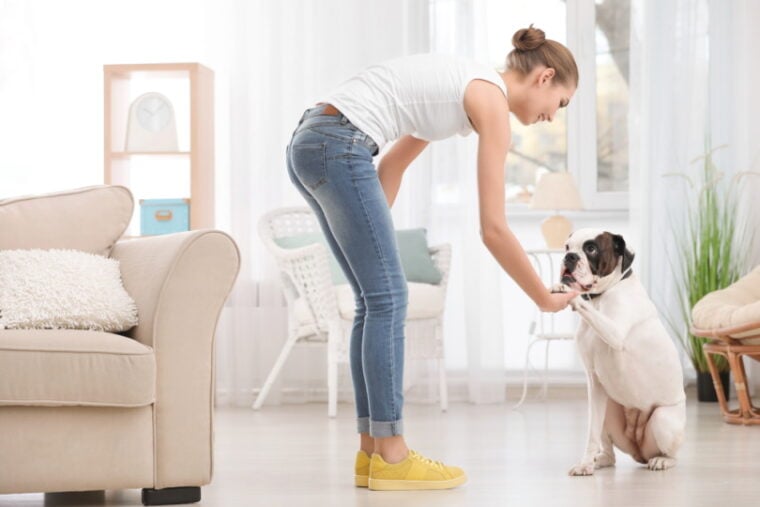
Dogs are some of the best companions, but they’re a massive responsibility. They require regular feeding, grooming, health care, exercising, and plenty of love. They’re also incredibly curious, especially as puppies, and have a habit of experiencing new things by putting them in their mouths. Unfortunately, this means that one of the best ways to keep your pup out of harm’s way is by dog-proofing your home and making it dog-friendly in the process. But thankfully, we are here to help!
The first step of dog-proofing requires you to drop to your dog’s eye level. Go and sit on your floor and look for anything that may catch your dog’s eye. If you end up staring at cables or potentially poisonous plants, remove them or place them on a higher surface that your dog can’t reach. This is a great start, but dog-proofing doesn’t end there! Keep reading as we share 12 great tips with you on how to better dog-proof your home.
The 12 Tips to Dog Proof Your Home
1. Establish No-Go Zones
There is nothing wrong with establishing boundaries, especially in an effort to keep your dog safe. If you’ve got a few rooms in your home that contain things that you need but your dog shouldn’t be around, put up a pet gate to block them from entering that room.
An office area is a good example of a room in your house that you may not want your dog to have access to. Offices tend to have computers with many electrical cables or laptops with chargers and external memory drives that contain valuable information that cannot risk being chewed up.
If you’re a plant lover and simply cannot part with your Fiddle Leaf Fig, you could place them in your office or another no-go zone to keep them away from your dog and forgo any potential issues!
2. Place Down Pee Pads
If your dog is still getting potty trained or you live inside an apartment, consider buying some pee pads for your dog to relieve themselves on. In a pinch, if you need to skip a late night run outside for your dog to pee, and you forget their leash in your haste and they go walkabout, having some pee pads might mean the difference between a lost pup and one that isn’t.
With pee pads, if you keep them out consistently, your dog also has a designated area to relieve themselves instead of going wherever they deem fit. It keeps your floors and carpets clean and is an excellent way of training your dog. And can help if you need to travel in the future, and don’t have easy access to outdoor spaces for your dog to relieve themselves- so safety and convenience are sorted!

3. Install a Pet Door
If your yard or outside area is dog-proofed and secure, consider installing a pet door. It will give your dog easy access to your yard to relieve themselves or to get some fresh air and stretch their legs. It also allows your dog to come inside when they’re too hot outside or want to snuggle up on their bed. It’s ideal for while you’re at work and are unable to open the door to let your dog in and out.
If you get a smart pet door, you’ll have a lot more control because you can lock the pet door if you don’t want your dog going outside for whatever reason. It tracks how often and at what times your dog has gone in and out through the pet door to keep you informed on their whereabouts from your phone.
4. Remove Toxic or Dangerous Items
Many people prefer to include their kitchens as a no-go zone for their dogs because kitchens have sharp objects that can cause injuries, foods that can make dogs sick, and cleaning products that are poisonous if ingested. Some people also keep their medicine in their kitchen.
If you can’t get around blocking this room off, be mindful of all the items that your dog may innocently lick up or run off with. Be sure to keep all medicine far out of your dog’s reach. Never leave food or cleaning detergents open or unattended when your dog is around, and make sure that your knives and forks are packed away, as well as the trash and leftovers!
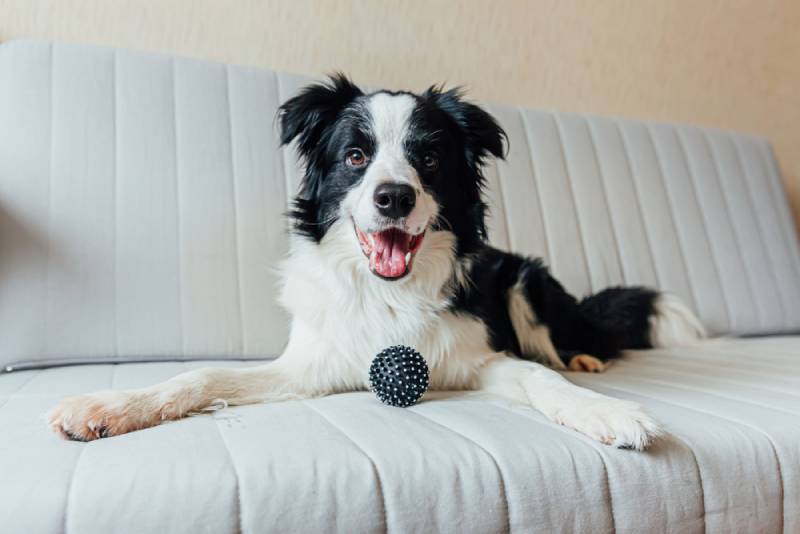
5. Get a Trash Can Lid
Dogs are notorious for rummaging in the trash can—unlike humans, dogs love the smell of garbage, and it unleashes their curiosity. Unfortunately, the trash can contains many dangerous items and is usually a mixture of everything you’ve thrown away from around the house. Items such as razors, wrappings, empty containers as well as old food could be in your trash can.
If your dog manages to chew into your trash can or topple it over, they could choke on or become very sick from its contents. Protect your dog by placing your waste in a durable trash can with a secure lid. You can take it a step further and store your trash can in a cupboard with a lock, as this will keep it out of your dog’s sight.
6. Don’t Leave Small Objects Unsupervised
If you have small children, they’ll want to play with their small toys in the living room while you watch TV or work around the home. However, if you have a dog that loves to chew, you’ll need to supervise playtime. Toys such as Legos are small enough to become lodged in your dog’s throat and should never be left lying around.
Toys aren’t the only concern. Objects such as jewelry, bobby pins, hair ties, candles, etc., are all items your dog may try to chew on and ingest with the risk of becoming lodged in their gastrointestinal tract.
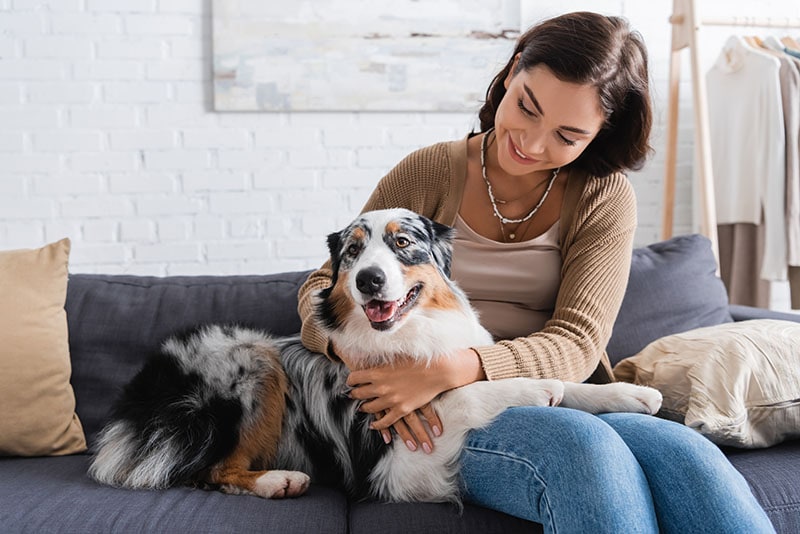
7. Use Child-Proof Locks
Many people claim that puppies are harder to look after than children. Although this might depend on your perspective, they certainly do keep their owners on their toes and require much of the same equipment that is used in childproofing. Some dog breeds are problem solvers and are intelligent enough to figure out how to open doors and drawers when they can smell something that sparks their interest on the other side.
As impressive as it is when your dog can open your cabinet, it can be dangerous. Many people place items or products that are harmful to their pets in cupboards and drawers to keep the items away from them, but if your dog can open the drawers themselves, it’ll be a big problem.
Consider using child-proof locks to prevent your dog from opening your cabinets.
8. Keep Windows and Doors Closed
Whether you live in a tall apartment or a home with a yard, you should keep the windows and doors closed when you’re not around to prevent your dog from escaping. If you have already dog-proofed your yard, this might not be as high of a concern for you. However, if your yard has access to the street or a pool without a gate or cover, your dog could find themselves in a dangerous position.
Keeping the doors closed around your home is a good habit to develop as it protects your dog from getting ahold of hazardous items in a moment of forgetfulness. If you’ve left jewelry on your bed and walked out of the room to get something, your dog might run off with it, but if you’ve closed the door, it prevents such scenarios. Keeping your bathroom door closed will prevent your dog from chewing on toilet paper and drinking out of your toilet.
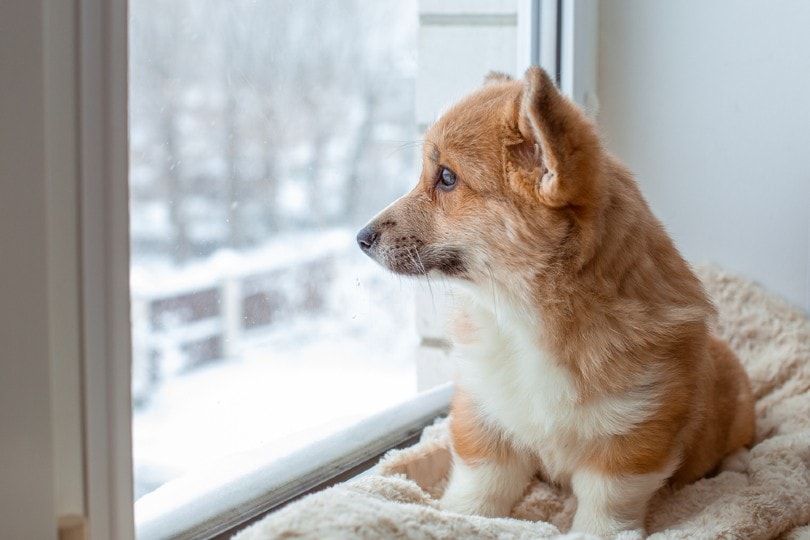
9. Use a Fireplace Screen
Dogs love watching the fire and lying near it for warmth. However, fires, even in your fireplace, are dangerous to curious dogs. Never allow your dog near an open fire or one that has gone out. If your dog eats the coals and ashes, they can become sick.
All dog owners with fireplaces should get a fireplace screen to prevent their dogs from getting burnt or having access to the fireplace. The screen also protects your floor and reduces any risk of the fire spreading.
10. Check Your Plants
Keeping plants in your home has many benefits, but many types are toxic to dogs. It’s important to know the name of the plants you have around your home and yard and research each of them to determine whether they’re safe to be around your dog or not.
The ones that are toxic to your dog should be placed in a no-go zone or on a top shelf that your dog cannot reach. If you feel more comfortable removing all the toxic plants from your home and yard, offer them to your friends and family. Continue to check your yard each season, as different plants bloom at different times throughout the year.
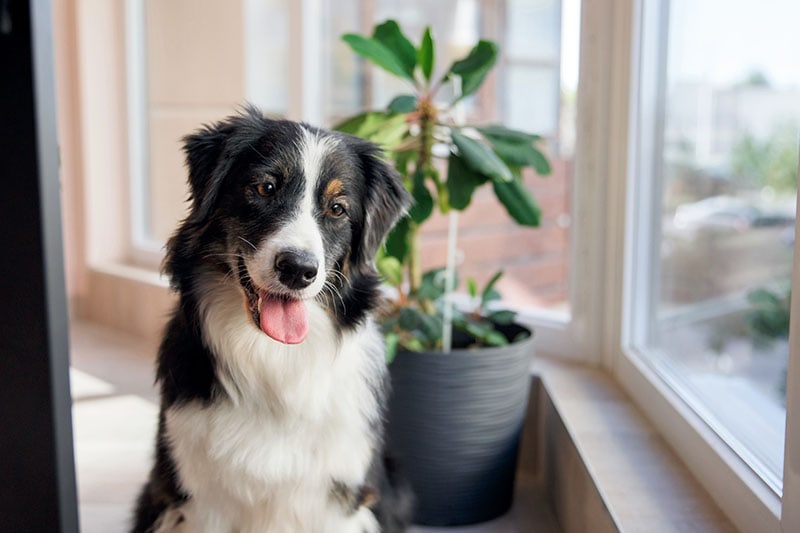
11. Protect Your Furniture
It’s devastating when you’ve recently bought a beautiful piece of furniture, and then your dog’s dirty paws stain it, or they chew the wooden legs. To protect the legs of your furniture or tables, consider wrapping them with sisal rope. Your dog’s teeth won’t reach the wood, and the rope gives a rustic look.
To protect the fabric on your furniture, use dog-proof upholstery that is waterproof, easy to clean, doesn’t trap smells or hair, is resistant to nails, and, if possible, removable. Low-pile fabrics, woven fabrics, protected fabrics, and outdoor fabrics are great options to consider around your dog.
Stay away from light colors and for extra protection, place one of your dog’s clean blankets on your sofa before they climb on for a cuddle.
12. Secure Your Backyard
Your house isn’t the only area that needs dog-proofing—your yard does too. Dogs run, play, and become mischievous in the yard, so it’s important to secure it and eliminate any danger zones. Because a yard usually leads onto a road or open space, make sure that your dog cannot dig under the gate or fence or jump over it. Also, check the latches and replace them if they’re loose or if they’re the type that your dog can open themselves.
Be mindful of the treatment you spray on your grass or the fertilizers you use for your plants. Some types are poisonous to dogs, so make sure to read the label first. Remove any mushrooms, plants, or flowers that are toxic to dogs. Make your pool a no-go zone by placing a fence around it. Even if your dog can swim well, they shouldn’t have access to your pool when unsupervised.

Conclusion
Dog-proofing your home is about creating an environment that is safe, secure, comfortable, and convenient for your dog. It’s also a way to protect your belongings, surfaces, and upholstery from your dog’s claws, drool, and teeth. Dogs are curious, and instead of touching interesting objects as humans do, they lick them or place them in their mouths. It’s important to get down to your dog’s eye level and look for all the objects, cables, plants, and substances that can be harmful to them and remove those items from their reach.
Featured Image Credit: Africa Studio, Shutterstock







